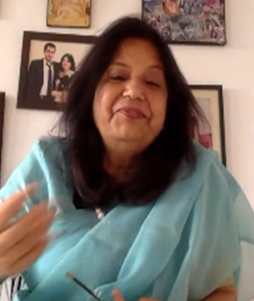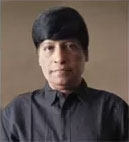
Ms Rajni Sekhri Sibal narrating her experiences about the book “The Haunting Himalayas” during the webinar. IAS Officer Rajni Sekhri Sibal relives and recounts her mystic experiences of the Himalayas in a lyrical narration that is patently her own.
There is something ethereally compelling about Ms Rajni Sekhri Sibal’s latest book “The Haunting Himalayas.” Not just because the book has an esoteric backdrop of pine forests and quaint towns and villages nestling the awe-inspiring mountains. For the quintessential writer, it wafts a natural fragrance of an inherent literary flair that blends with the gift to encompass the beauty of ambience and characters in intense words. This came through resonatingly at a webinar during which encomiums were showered on the former civil services officer who has pursued writing as an abiding passion.
Ms Sibal’s writing has touched different genres — from managing disasters to short stories, and in each, she displays her deft touch with the subject that she dwells upon. “The Haunting Himalayas” is an anthology of short stories and not a voluminous book but in a short, crisp work, she reveals that she has sensitive mind that her accomplished pen straddles with consummate ease of expression.
Quite overwhelmed by the spontaneous and genuine appreciation of the book, Ms Sibal elaborated on how her sojourn with the Himalayas and its quaint characters impacted her. “It is a collection of stories appearing to border on fantasy but I have been conscious enough not to allow myths to dominate the truth.” Her tryst with the Himalayas right in the midst of a Covid pandemic was a revelation of sorts. “I soaked in the strange its evildom and bliss, especially towards the evenings. I realized there was something definitely more than meets the eye. The bearing and the mien of the imposing Himalayas with its real life characters are a result of my heightened senses. I would rather say the book is an ode to the Himalayas and its inhabitants.”
Prof ShormishthaPanja, Professor of English& Director, Institute of Lifelong Learning, University of Delhi, an acknowledged Shakespearean scholar, narrated her experience with ghost stories. “There are comic ghost stories and there are scary ghost stories. Ms Sibal’s stories have a pleasant flavour despite the strange characters she portrays through them. What is strange does not have to be necessarily bad. Her stories are uncanny without the usual suspects of sex or violence. I was particularly drawn to the Fakir’s story which transports the reader from the mundane to the extraordinary.”
Ms Panja pointed out that ghost stories were not new but their styles had changed over the years. “There were Roman and Greek ghosts in Shakespeare’s stories. The genre evolved between 1880 and 1914. Most contemporary authors including Charles Dickens and India’s own Rabindranath Tagore dabbled in them. Ms Sibal’s narration of ghost stories is pleasing and catchy. Her characters permeate through pine forests, from the upper Himalayas to the Gangotri.
Referring to the book, Ms Richa Mishra, journalist with The Hindu Business Line, also a speaker at the webinar, said ghosts and spirits do exist where I lived. “I have always romanced the nature with the likes of (William) Wordsworth, beyond my professional work relating to politics and economics. “I loved the Smiley story. In the very first few sentences, Ms Sibal how good she is. As journalists we are always programmed to think of a good intro in 100-150 words. She is simple, straight and sans flamboyance but she draws you into the book with a style that has a cinematographic appeal. I would like to meet Ms Sibal to know how the characters in her book affected her. Very few people write short stories these days. Ms Sibal’s has woven lovely threads in her story.
Earlier, Gurcharan Das, author, former CEO of Procter & Gamble India, & Managing Director, Procter and Gamble Worldwide (Strategic Planning), chaired the session and made introductory remarks. “I have been a student of Science so I have rarely bothered to look at ghost stories. I wonder how Ms Sibal got into the transcendental but she has left me far behind. I do believe in the Himalayas and I thank God for them. Ms Sibal creates a lovely backdrop and her descriptions invoke the awe-struck feeling of spirits like you do in Shakespeare’s Hamlet and Macbeth.
The speaker session was followed by a question and answer session, Replying to a question by The Resource 24×7, Ms Sibal explained she handled the subject and its characters with restraint and avoided the temptation to go verbose with them. The webinar was watched/heard by over 700 people and well received.
It is rare to straddle and juxtapose two different worlds, especially when your professional calling happens to be far removed from your predilections. Ms Rajni Sekhri Sibal, an IAS officer and the first lady to top the Civil Services Examination in 1986, is a striking example in point. After the critical acclaim that she won for four of her books “Kamadhenu: Cows of India”, “Clouds End and Beyond”, “Are You Prepared for a Disaster” and “Fragrant Words”, the otherwise busy bureaucrat has squeezed time out to spin another winner in “The Haunting Himalayas.”
Each book carries with it a literary flavour that makes you wonder how Ms Sibal harnesses her literary gift with consummate ease. In “The Haunting Himalayas”, a gripping anthology of eight short stories, she explores the multi-splendored mystique of the Himalayas, a living symbol of Mother Earth’s grandeur. Through the stories she recreates the majesty of the misty winter evenings and the dusky mysterious skies over peaks capped by silvery snow.
She quotes the experienced wisdom of an unlettered sage who she was occasioned to meet fleetingly towards the end of what she describes as an arduous, uphill journey. By her own admission, it opened her eyes to appreciate that is a lot more to the world than meets the eye. The words “fuzzy realm that separates the here and the now from what is ethereal” forms the crux of her esoteric experiences that happened during a trek of the Himalayas – from Gangotri Glacier to Tapovan – the latter being a quaint, high-altitude meadow encircled by picturesque, snow-capped mountains.
Ms Sibal makes a candid admission that her experiences were something of grey between the Black and White. It struck her that beyond the boundaries of Science, there are things that are still blanketed in mystery and create a room for uncertain probabilities. She had to liberate her mind from the shackles of rigid empiricism to veer round to this view. The Haunting Himalayas is an outlet of that frank admission.
Ms Sibal gives eloquent expression to those arcane experiences with the sensitivity they eminently deserve. The entire narrative is lyrical and sublime, which is the hallmark of her writing. The stories consolidate her premise that “you begin to comprehend that what others perceive is not a mere myth simply because you do not.”
The stories make the readers delve into her experiences of eerie sightings, strange sounds and ethereal events. The vintage and venerable Himalayas provide a perfect setting to lend credence to the occurrences she sketches in vivid details. Through the awesome canvas of the Himalayas, she stitches spellbinding stories that have a romantic blend of myth and reality. The recital comes through resonatingly with rhapsodic references to pristine pine-covered ranges, frosty mornings, rosy sunsets that unfold the imperceptible facets of the cosmic truth.
Ms Sibal accomplishes in driving her point home that the Himalayas throw up fascinating but unknown dimensions of there being more to the world than meets the eye. It is not often that for someone who comes from the Civil Services cadre can embroider and seamlessly merge Prose and Poem with the literary dignity that rides on human sensitivity.
The abstruse events in the book are based on true sightings. Ms Sibal puts things in perspective by asserting that the fantasy is merely peripheral and does not overtake the reality of the true experience. Some of the conversations in the short stories have evolved from her imagination. The nucleus is garnished with conversations and creativities to build a legend. Mystic thrill apart, the stories also unfurl a graphic journey from a village in Lahaul Spiti at the confluence of Chandra and Bhaga, through the hills of Shimla and Mussoorie, to Harsil on the banks of the Bhagirathi and on to Joshimath and Badrinath in Tehri Garhwal. It is also a veritable cruise to the ancient kingdom of the Varmans in Chamba in Himachal Pradesh; and then right across to the Pauri Garhwal region of Uttarakhand. The Haunting Himalayas is an apt tribute to the magnificence of Himalayas and their treasure trove of magical mysteries.
As Ms Sibal points out: There is nothing more charming than sitting around a fire made of pine logs with family and friends and reading or listening to stories that appear magical in the warm amber glow of the fire. I have charming memories of several such evenings.” Little wonder the spontaneity and lucid flow of words in a book that takes the readers on a different trip altogether.

A Column By
Raju Kotri – Editor
The Resource 24X7
A Journalist With 4 Decades of Experience With Leading Media Houses.
